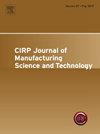Smoothed particle Galerkin modeling and experimental validation of pendulum-based scribing of porcine clots
IF 5.4
2区 工程技术
Q2 ENGINEERING, MANUFACTURING
CIRP Journal of Manufacturing Science and Technology
Pub Date : 2025-04-04
DOI:10.1016/j.cirpj.2025.03.013
引用次数: 0
Abstract
Advancing cutting-based surgical technologies requires the knowledge of the interaction between tools and soft biomaterials which undergo large deformations before failure. The pendulum-based scribing is applied to deform the soft porcine clot and quantify its interaction with the tool. The pendulum apparatus has a 307 mm long swing arm with a 1 mm diameter blunt tip steel wire for scribing the porcine clot, which is cured by mixing the porcine whole blood and coagulant in a mold. After curing, the cover of the clot mold was removed to expose grooves of porcine clots in a fixture. Clot specimens were scribed at maximum speeds of 0.76 and 1.47 m/s. The cutting force was captured by a piezoelectric dynamometer beneath the clot fixture. High-speed video was recorded to observe the clot cutting and deformation during the scribing process. A smoothed particle Galerkin (SPG) model of the scribing process was developed to gain insights into the material deformation and to identify clot material properties for scribing by validating with experimentally measured scribing forces. The model exhibited concordance with experimental cutting force data, showing a deviation of 6.9 % at 0.76 m/s and 8.3 % at 1.47 m/s.
光滑粒子伽辽金模型及基于钟摆的猪血块刻划实验验证
推进基于切割的外科技术需要了解工具和软生物材料之间的相互作用,这些材料在失效之前会发生很大的变形。基于钟摆的刻划应用于变形软猪血块并量化其与工具的相互作用。摆摆装置有307毫米长的摆臂,有直径1毫米的钝尖钢丝,用于刻划猪血块,将猪全血和凝血剂混合在模具中固化。固化后,除去凝块模具的盖子,露出固定装置中猪凝块的凹槽。在0.76和1.47 m/s的最大速度下刻写凝块标本。切割力由血块夹具下方的压电测功仪捕获。高速录像,观察刻划过程中血块切割和变形情况。建立了划痕过程的光滑粒子伽辽金(SPG)模型,通过实验测量的划痕力验证,深入了解材料变形,并确定划痕时的凝块材料特性。在0.76 m/s和1.47 m/s下,模型误差分别为6.9%和8.3%。
本文章由计算机程序翻译,如有差异,请以英文原文为准。
求助全文
约1分钟内获得全文
求助全文
来源期刊

CIRP Journal of Manufacturing Science and Technology
Engineering-Industrial and Manufacturing Engineering
CiteScore
9.10
自引率
6.20%
发文量
166
审稿时长
63 days
期刊介绍:
The CIRP Journal of Manufacturing Science and Technology (CIRP-JMST) publishes fundamental papers on manufacturing processes, production equipment and automation, product design, manufacturing systems and production organisations up to the level of the production networks, including all the related technical, human and economic factors. Preference is given to contributions describing research results whose feasibility has been demonstrated either in a laboratory or in the industrial praxis. Case studies and review papers on specific issues in manufacturing science and technology are equally encouraged.
 求助内容:
求助内容: 应助结果提醒方式:
应助结果提醒方式:


